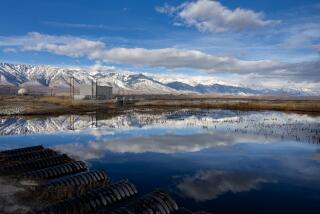Conservation Tactics for a Long Dry Spell : Plants: With the drought entering its fifth year, gardeners will have to be wise as well as stingy in their watering.
Here we are, halfway through winter with spring right around the corner and we’ve had but one inch of rainfall, enough to wet most soils to a depth of only a foot. Dig deeper and you are likely to find powder-dry soil. This is the fifth year of drought, and there is no reservoir of moisture left in the soil.
Soils are so dry that patches in my own garden didn’t even get wet because that gentle rain failed to soak in, and ran off to slightly lower ground. (A light cultivation with a steel rake or cultivator will help roughen the soil and improve penetration--a good thing to do before the next rain.)
Unless things change drastically, it looks like this year is going to be the “big one” droughtwise. All of Southern California, not just Santa Barbara, may finally feel the pinch of no rain locally and no snow in the Sierra.
The Metropolitan Water District is asking member agencies to save 15% and maybe 20%. On Feb. 1 the Los Angeles Department of Water and Power will give its recommendations to the City Council after looking at the January snow pack. Mandatory rationing is expected.
So what is a gardener to do? It may not yet be time for drastic action but it is time to put the garden on a budget. The Los Angeles State and County Arboretum in Arcadia is already on a tight budget, trying to save substantial amounts of water typically wasted by a rapidly deteriorating, 30-year-old irrigation system.
Taking a lesson from drought-stricken Santa Barbara, they are trying to save the trees and shrubs, the most critical components of that public garden and any private garden.
“We are letting the lawns and ground covers go,” said Superintendent John Provine. “They can always be brought back when water is again available.”
They are deep-watering the trees and shrubs, hoping to wet that dry soil a foot down, irrigating during the early-morning hours so none is wasted in the afternoon wind. They also irrigate infrequently. (To deep-water, let the water run slowly for at least an hour or cycle sprinklers on and off.)
Every gardener is now equipped with a tubelike sampling device called a water probe, and they do not water until the soil is dry a foot to 18 inches deep.
They are also mulching heavily, killing two birds with one stone--the mulches conserve water and get rid of “green waste” since their mulches are home grown and ground up on the spot.
The arboretum’s tactics could--and should--be put into effect immediately by homeowners.
Begin sampling the soil around trees and shrubs and water them deeply when the soil is found to be dry a foot down. Do not count on automatic timers, most of which are designed only to turn the water on long enough to wet the top few inches of soil.
Water only in the mornings. Save every leaf and trimming, chop them up with a machete if necessary, and use them as a mulch. “We are putting down mulches to replace the ground covers around trees and shrubs,” Provine said.
The arboretum’s gardeners are also changing sprinkler heads or fixing them so they better distribute water to where it is needed. Just like homeowners, they are trying to keep water off of paving or from running down the gutter. These are also ideas to try now.
And, when gardeners plant something new at the arboretum, they are looking at more drought-tolerant replacements, and they’re grouping plants according to water needs, so that plants from low-rainfall areas grow together and others can get the extra attention.
This is another tactic home gardeners can adopt immediately. New trees and shrubs in particular should be able to fend off drought, and thirsty plants should be kept together in a location where they alone can get the extra water they need--even if that water comes from the bathtub, should the drought continue.
What about roses and fruit trees that are usually planted bare root at this time of the year? Roses, in particular, are thirsty plants, but efficient irrigation equipment, drip systems for instance, can make them a possibility in the home garden, if they do not dominate the garden. A few carefully tended roses will not do too much damage to the water budget.
Even spring flowers are still a possibility. For extra insurance, you might use one of the new water-storing polymers such as Broadleaf P4 in each planting hole or incorporated into the soil. These will help ensure that water stays in the soil where roots can reach it.
It is a pretty safe bet that this is going to be another dry year and that rationing will be in effect everywhere in Southern California by summer at the latest.
Don’t wait until then to do something about it. New plantings should go in the ground soon to take advantage of what rain we do get, and trees and shrubs need water now to make up for the lack of winter rain.
Put the garden on a budget this weekend.






